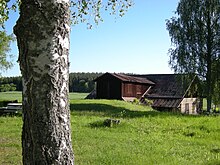Rällingsberg mine
Coordinates: 60 ° 28 ′ 3 ″ N , 16 ° 2 ′ 35 ″ E
The Rällingsberg mine is a former iron mine in Långshyttan in Dalarnas County , Sweden .
history
In the winter of 1840/41 the farmer Clas Westerholm discovered a 700 meter long iron ore vein east of Lake Rällingen with a borrowed geological compass . On January 30, 1841, his claim to the find was confirmed. He became half the owner of the deposit, the other half belonged to the landowner of Klosters bruk . In June of the same year, the mining contracts in the Rällingsbergsgruvan were signed. After six years, Westerholms shares were taken over by Klosters bruk , which became the sole owner. Klosters AB was founded in 1871, and Rällingsbergs gruvaktiebolag was formed as a subsidiary in 1892 .
The largest mine, Rällingsbergs gruva , was an open pit mine. There were also the three smaller Ågruvan , Myrgruvan and Sjögruvan .
- Ågruvan was the northernmost mine in the ore field. It was tapped on February 27, 1891. The actual mining began in 1903 at a depth of 40 to 53 meters, where a 115 meter long ore strip was found. The quality deteriorated further down. Mining was abandoned in 1927 at a depth of 110 meters.
- Sjögruvan was south of Ågruvan and was also called Mellanschaktet . After some major ore discoveries at a depth of 40 meters, the work was stopped in the early 1920s.
- Myrgruvan was the southernmost of the four pits within the field. It was tapped on April 30, 1842. Only a few larger finds have survived, further data on the digging time and depth of the pit are unknown.
The ore enrichment took place in the mine in Rällingsberg, the ore from Ågruvan and Sjögruvan was transported there by rail or cable car. From Rällingsberg the crushed ore was brought to the ore processing in Långshyttan by barge. In 1868 the first tracks were laid to bring dead rock to an overburden dump, in 1872 a horse tram was built and in 1882 the horses were replaced by steam engines. In 1891 the Byvalla – Långshyttan railway was inaugurated.
The mine was closed in 1932.
Today the area is part of the Husbyringen Eco-Museum . The mine house , the machine house and the transformer station as well as the remains of the processing plant and the transport system with canals, railroad and cable car are still present.
See also
Individual evidence
- ↑ Pia Hilborn and Miljöenheten (Environmental Section), Länsstyrelsen Dalarna County: Discover Husbyringen . Länsstyrelsen Dalarnas län.
- ↑ a b Jan. Stage Mark, Kurt Östlund, Jan-Olof Carlsson: Rällingsbergs Gruva. (History of the pit). langshyttan.nu, May 1992, accessed July 22, 2014 (Swedish).
Web links
- Jan Stagenmark, Kurt Östlund, Jan-Olof Carlsson: Rällingsbergs Gruva. (History of the pit). langshyttan.nu, May 1992, accessed July 22, 2014 (Swedish).
- The mine in Rällingsberg. Stiftelsen Husbyringen, accessed on July 22, 2014 .
- Husbyringen, Sveriges första ekomuseum. Stiftelsen Husbyringen, accessed July 22, 2014 (Swedish).
